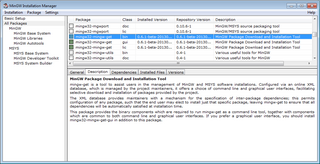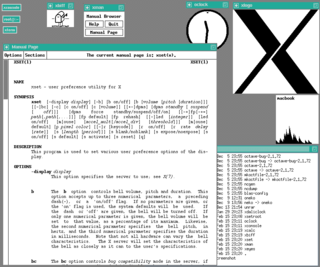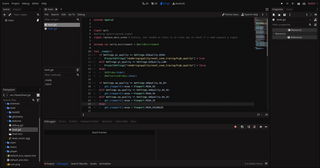Related Research Articles

Bash, short for Bourne-Again SHell, is a shell program and command language supported by the Free Software Foundation and first developed for the GNU Project by Brian Fox. Designed as a 100% free software alternative for the Bourne shell, it was initially released in 1989. Its moniker is a play on words, referencing both its predecessor, the Bourne shell, and the concept of rebirth.

A shell script is a computer program designed to be run by a Unix shell, a command-line interpreter. The various dialects of shell scripts are considered to be command languages. Typical operations performed by shell scripts include file manipulation, program execution, and printing text. A script which sets up the environment, runs the program, and does any necessary cleanup or logging, is called a wrapper.

A Unix shell is a command-line interpreter or shell that provides a command line user interface for Unix-like operating systems. The shell is both an interactive command language and a scripting language, and is used by the operating system to control the execution of the system using shell scripts.
An environment variable is a user-definable value that can affect the way running processes will behave on a computer. Environment variables are part of the environment in which a process runs. For example, a running process can query the value of the TEMP environment variable to discover a suitable location to store temporary files, or the HOME or USERPROFILE variable to find the directory structure owned by the user running the process.

MinGW, formerly mingw32, is a free and open source software development environment to create Microsoft Windows applications.

In computing, text-based user interfaces (TUI), is a retronym describing a type of user interface (UI) common as an early form of human–computer interaction, before the advent of bitmapped displays and modern conventional graphical user interfaces (GUIs). Like modern GUIs, they can use the entire screen area and may accept mouse and other inputs. They may also use color and often structure the display using box-drawing characters such as ┌ and ╣. The modern context of use is usually a terminal emulator.
In computer programming, a one-liner program originally was textual input to the command line of an operating system shell that performed some function in just one line of input. In the present day, a one-liner can be
Expect is an extension to the Tcl scripting language written by Don Libes. The program automates interactions with programs that expose a text terminal interface. Expect, originally written in 1990 for the Unix platform, has since become available for Microsoft Windows and other systems.

A command shell is a command-line interface to interact with and manipulate a computer's operating system.

In computing, a shell is a computer program that exposes an operating system's services to a human user or other programs. In general, operating system shells use either a command-line interface (CLI) or graphical user interface (GUI), depending on a computer's role and particular operation. It is named a shell because it is the outermost layer around the operating system.

Tkinter is a Python binding to the Tk GUI toolkit. It is the standard Python interface to the Tk GUI toolkit, and is Python's de facto standard GUI. Tkinter is included with standard Linux, Microsoft Windows and macOS installs of Python.

Tk is a cross-platform widget toolkit that provides a library of basic elements of GUI widgets for building a graphical user interface (GUI) in many programming languages. It is free and open-source software released under a BSD-style software license.
A batch file is a script file in DOS, OS/2 and Microsoft Windows. It consists of a series of commands to be executed by the command-line interpreter, stored in a plain text file. A batch file may contain any command the interpreter accepts interactively and use constructs that enable conditional branching and looping within the batch file, such as IF, FOR, and GOTO labels. The term "batch" is from batch processing, meaning "non-interactive execution", though a batch file might not process a batch of multiple data.
GNU Emacs is a text editor and suite of free software tools. Its development began in 1984 by GNU Project founder Richard Stallman, based on the Emacs editor developed for Unix operating systems. GNU Emacs has been a central component of the GNU project and a flagship project of the free software movement.

In computing, a script is a relatively short and simple set of instructions that typically automate an otherwise manual process. The act of writing a script is called scripting. A scripting language or script language is a programming language that is used for scripting.

A command-line interface (CLI) is a means of interacting with a computer program by inputting lines of text called command lines. Command-line interfaces emerged in the mid-1960s, on computer terminals, as an interactive and more user-friendly alternative to the non-interactive interface available with punched cards.
Tcl is a high-level, general-purpose, interpreted, dynamic programming language. It was designed with the goal of being very simple but powerful. Tcl casts everything into the mold of a command, even programming constructs like variable assignment and procedure definition. Tcl supports multiple programming paradigms, including object-oriented, imperative, functional, and procedural styles.
In computer science and visualization, a canvas is a container that holds various drawing elements. It takes its name from the canvas used in visual arts. It is sometimes called a scene graph because it arranges the logical representation of a user interface or graphical scene. Some implementations also define the spatial representation and allow the user to interact with the elements via a graphical user interface.
References
- ↑ Welch, Brent B.; Jones, Ken; Hobbs, Jeffrey (2003). Practical Programming in Tcl and Tk (4th ed.). Upper Saddle River: Pearson Education, Inc. - Prentice Hall PTTR. p. 25. ISBN 0-13-038560-3.
- ↑ "ActiveState Tcl". activestate.com. Retrieved 2025-01-03.
- ↑ "Cygwin". wiki.tcl-lang.org. Retrieved 2025-01-03.
- ↑ "AndroWish". wiki.tcl-lang.org. Retrieved 2025-01-03.
- ↑ Gray, Mary (May 20, 1988), Wish – A Window-Based Shell for X (PDF), Computer Science Department, University of California, Berkeley, retrieved November 8, 2016
- ↑ Flynt, Clif (2012-01-17). Tcl/Tk: A Developer's Guide (3rd ed.). Elsevier: Morgan Kaufman. p. 17. ISBN 978-0-12-384717-1.